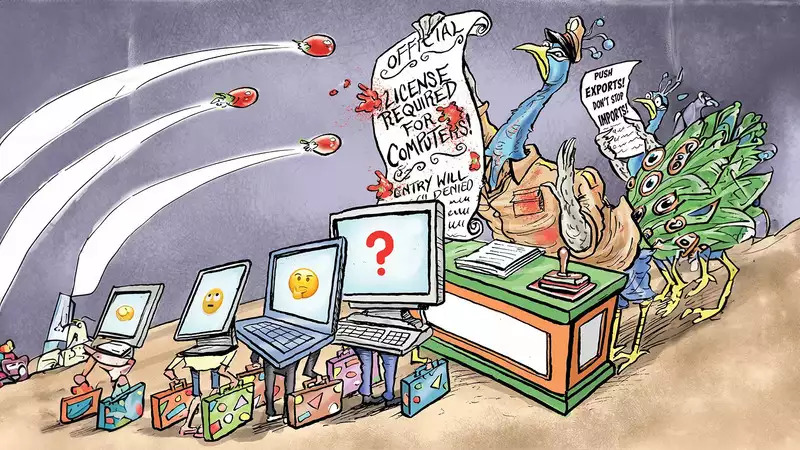
Has the License Raj come back? No, but here is a cautionary tale
On August 3rd the government dropped a bombshell, frightening both industry and consumers. The free import of personal computers, laptops and tablets was banned with immediate effect. A license would be needed henceforth to import a computer. Apple, Dell and Samsung stopped orders from abroad. Students asked where to queue up for a license. Parents wondered if prices would go up. IT companies worried about future of their business. There were anxious calls from overseas investors, asking if the Indian economy was in trouble. “Doesn’t India have comfortable reserves?” asked one. Another hoped that India was not going the way of Sri Lanka and Pakistan.
In an effort at damage control, the ministry extended the licensing deadline the next day by three months. It tried to reassure the panic stricken nation that licences would be given liberally and prices would not go up. The objective of the move, it explained, was to reduce dependence on imports and increase domestic manufacturing, A spokesperson added privately that because of security concerns, India needed to curb imports from China, which supplied 60% of the computers.
So, is this a return of the ‘license raj’? No, not really. Despite this badly botched intervention, India does need to push the global giants to make in India. It also needs to curb the bleeding $100 billion trade deficit with China and be mindful of legitimate security concerns vis a vis that country. But all these objectives could have been achieved in a quieter, sensible way without resorting to the terrible instrument of licensing.
The other question is, why has India failed to make computers at home? With its rise as a global IT power, India should have become a major exporter by now. If it could become a leading exporter of software and IT services, why not computer hardware? A key reason is India’s zero duty commitment to the 1997 Information Technology Agreement with WTO. Although this agreement has brought many benefits, including enabling the rise of our software industry, it killed the hardware industry. Zero duty brought in a rush of foreign made computers. The locally made ones could not compete because of significant disadvantages -- poor logistics, infrastructure, the high cost of land, power, and capital. As a result, promising companies like HCL and Wipro had to shut their hardware divisions.
At the same time, our competitor nations, especially China, began to offer huge subsidies to foreign companies in return for making in China. In a belated move, our government has come with a production linked incentive (PLI) to encourage manufacturers to make in India. However, there were few takers for it. Whereas Indian disadvantages were 8%-12%, the PLI offered only a 3% subsidy. The government then launched a second, more generous PLI, which too doesn’t seem to have succeeded. In such a situation, the normal course would have been to incentivise local manufacture by raising import duties. This is what was done in the case of cell phones. But India was bound by a zero duty to WTO. (We had got away with mobiles because they were not in the Information Technology Agreement.)
Stymied and desperate, the ministry resorted finally to licensing in order to push companies to make computers locally. It was a bad move. Economists and business people condemned it universally. It conjured nasty images of the dreaded pre-1991 license raj, when it took years to get a license, when shortages were commonplace, and bureaucratic discretion led to corruption. The public reaction was understandable. The computer today is ubiquitous, restricting it is like banning pencil and paper. Every student, business, and government depends on it. It is abrupt disruptions like these which give India a bad image as a difficult place to do business.
Well, the licensing announcement has succeeded in pushing manufacturers, including the global giants, to commit to local manufacture. The number of takers for the PLI subsidy has risen from 2 to 44 companies, according to a PTI report. Nevertheless, it would have been better to engage in a quiet, gentlemanly dialogue, giving companies a six month deadline. It would have done the trick. All the mayhem, panic, loss of trust, and damage to the nation’s reputation was avoidable. Global manufacturers themselves are wary of China and are seeking alternative locations to reduce their vulnerability. The Chinese influx, however, cannot be stopped overnight. As to national security, there are better ways than licensing to check for trapdoors and built-in security loopholes on laptops, endangering personal and enterprise data. The challenge for the government in the near future will be: how to exit the licensing regime without losing face.
This is a cautionary tale with a number of lessons for regulators. It is essential to have a vigorous on-going, off the record dialogue with industry. Ham-handed moves like licensing will quickly lose the trust of investors and the hard earned reputation of one’s country. Continuing consultations will help our regulators understand why investors prefer Vietnam to India despite our larger market. It is always better to use the carrot rather than the stick. The PLI scheme is a necessary carrot in order to become competitive. However, we must modify future PLI schemes to also incentivise local design and encourage component makers to shift to India. PLI contracts must specify an end date for high tariffs. The proof of a successful PLI is when the country joins the global supply chain and India becomes a manufacturing hub for the world. This has happened in the case of cars and will soon happen with mobiles. The mantra of successful countries is ‘push export’ rather than ‘stop imports’. India too must adopt this mantra and maintain openness in trade, investment and technology.